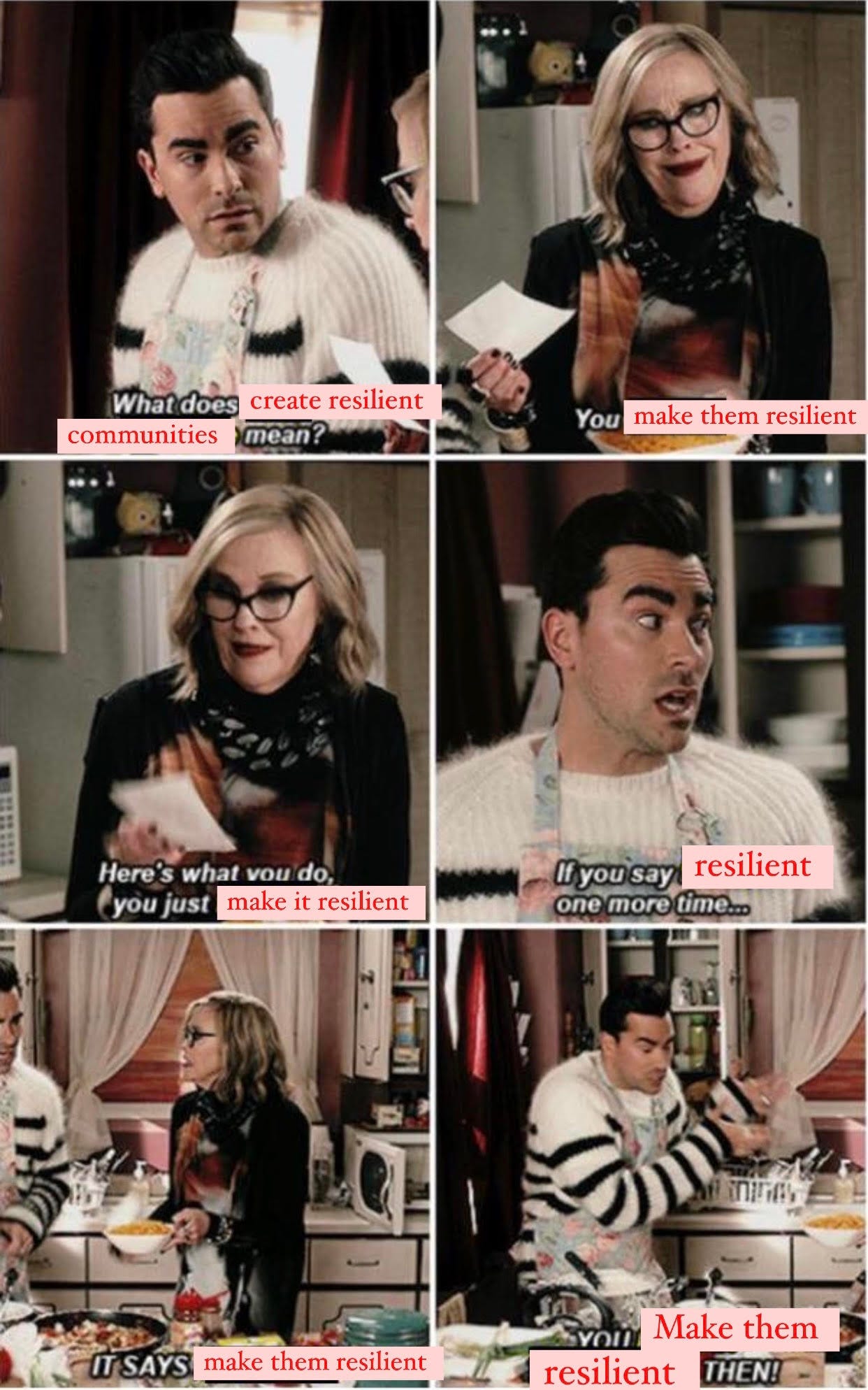This newsletter is a compilation of recent disaster ~things~ that I think are cool, important, or otherwise of interest to people who are intrigued with disaster (broadly defined). There’s a little something for everyone!
Hello Friends!
A little treat for you on a Friday afternoon.
The State of Emergency Management
Bad news: Emergency Managers are burnt out.
Good news: Deanne Criswell was officially confirmed as the new FEMA administrator.
This month continued with the push to vaccinate everyone in the United States. A friendly reminder that the pandemic is not over. Fear of a toxic wastewater reservoir collapse led to mandatory evacuations in Florida. This month had a below-average number of tornadoes but several communities (like this one in Louisiana) were affected.
I want to highlight some disasters outside the U.S. There was bad flooding from Cyclone Seroja in Indonesia and Timor-Leste. Cape Town battled a wildfire that among other damage destroyed archives full of Southern African history. Northern India and Nepal also faced forest fires that affected air quality. While vaccination is well underway in the United States, the pandemic is exploding in other parts of the world. The Biden administration is under increasing pressure to provide help to countries facing dire conditions like India.
La Soufrière is erupting on the island of St Vincent and help from the international community is needed. Dr. Jazmin Scarlet is the person to be following on Twitter for the best and latest information (along with local official sources). This disaster stands in stark contrast to the tourism that has developed around the Icelandic volcano and serves as a good reminder of why hazard doesn’t equal disaster.
Climate Crisis News
There was a lot of climate change related news this month. There have been all kinds of updates from our friendly neighborhood hazard scientists: The connection between cold waves and arctic sea ice loss. More on the relationship between climate change and hurricanes (they are still related, y’all). News on the so-called “doomsday” glacier and sea level rise. The west coast’s megadrought.
Hawaii’s legislature is set to become the first state to declare a climate emergency. It was Earth Day, Infrastructure Week (finally!), and Biden’s big climate summit. Much of these conversations were centered around mitigating climate change itself. This is good and obviously important but of slightly less interest for this particular newsletter. The bits we’re after are the ones that affect climate adaptation, specifically emergency management.
Those infrastructure plans? BIG repercussions for emergency management. The state of our infrastructure has a huge effect on our risk. Surely FEMA has some opinions. Also of note is what isn’t in the plan. Specifically, Which Homes Get Saved?
Finally, a Deb Haaland appreciation post. I’ve been really interested in watching how her leadership unfolds in the Interior Department. She’s working to center marginalized communities, tackling climate change, and prioritizing environmental justice which are all things that some other agencies *cough* FEMA *cough* should also be doing.
~MEME~ Break:
The Book of the Month:
“Disposable City: Miami’s Future on the Shores of Climate Catastrophe” by Mario Alejandro Ariza
This is a deeply personal book about the experience of watching a place fall into a changing climate. It negotiates the conflicting feelings that arise with an uncertain future. Science and research underlie the breadth of subjects covered, but this is an incredibly readable book. Ariza accomplished, for me, the incredibly delicate task of diffusing the book with humor at all the right moments (e.g., “nobody speaks fluent octopus”). This is a good one for anyone who cares about climate change but doesn’t want to read dense climate texts.
The Disasterology Monthly Newsletter gives this 10/10 stars.
You can read more here and buy it here.
Important Disaster Related Media Coverage This Month:
I ditched response this month. The other phases need our attention!
Mitigation
3 Youth Living and Organizing on the Frontlines of the Climate Crisis
Maia Wikler for Teen Vogue
Lake Michigan Faces Effects of Climate Change and Coastal Erosion
Ginger Zee for Good Morning America
A lurking earthquake fault has blocked Hollywood’s tallest building. Will it ever rise?
Rong-Gong Lin II for Los Angeles Times
On Virginia’s rural coast, resiliency and Chesapeake Bay conservation goals collide amid sea level rise
Sarah Vogelsong for Virginia Mercury
Recovery
Investigation suppressed by Trump administration reveals obstacles to hurricane aid for Puerto Rico
Tracy Jan and Lisa Rein for The Washington Post
The ‘Old American Dream,’ a Trap as the Floods Keep Coming
Rick Rojas for the New York Times
Thanks to Climate Change & COVID, Disaster Capitalism Is Thriving
Whizy Kim for Refinery 29
She survived Hurricane Sandy. Then climate gentrification hit.
Amir Khafagy for The Guardian
After the winter storm, a Texas mobile home community’s nightmare was far from over.
Alexandria Herr for Grist
Crises collide: Homeless in America when climate disaster strikes
Andrew McCormick for NBC News
‘Gateway to Poverty’: Calls Rise for a National Relief Fund for COVID-19 Victims’ Families
Dean Russell for The City
Were the Texas Blackouts a Crime?
Jonathan Tilove for Texas Monthly
After Texas freeze, immigrants play critical role in repairing tens of thousands of homes
Elizabeth Trovall for PRI The World
‘We Are Doomed’: Devastation From Storms Fuels Migration in Honduras
Natalie Kitroeff for The New York Times
Preparedness
Here’s how tornado warnings saved lives last week in Alabama
Matthew Cappucci for The Washington Post
Pandemic Wilderness Explorers Are Straining Search and Rescue
Ali Watkins for The New York Times
The essential – and dangerous – work prisoners do
Jessica Kutz for High Country News
Ice Storm Aftermath: More Climate Extremes Ahead for Galveston
Matt deGrood & Bob Berwyn for Inside Climate News
Weather Service Internet systems are crumbling as key platforms are taxed and failing
Matthew Cappucci & Jason Samenow for The Washington Post
As rainstorms grow more severe and frequent, communities fail to prepare for risks
Jim Morrison for The Washington Post
Weird Disaster Thing
I was fully in tears watching Bowen Yang on SNL as ‘The Iceberg That Sunk The Titanic’. Every line is PERFECT. Watch it more than once, trust me.
The End Bits:
I would love it if you’d forward this to your friends, post on social media, and undertake any other form of newsletter sharing you deem appropriate. They can sign-up here.
In case you signed up for this newsletter without knowing who I am (a bold choice!) you can read more about me on my blog, listen to this episode of Ologies, or follow me on Twitter and Instagram where I impulsively narrate my every thought.
The logo was made by my friend Gabi. You can check out her Instagram and hire her for all of your badass art related needs.
Finally, this newsletter is ~FREE~. I plan on keeping it that way because eliminating barriers to disaster knowledge is important. However, several people expressed an interest in financially supporting this work. I’ve created a “paid subscriber” option for $5 a month or whatever you’d like to give. The only difference between a free sign-up and a paid subscriber option is that you’ll be able to see the full archives of the newsletters. Really, this is just a way for those who want (and can) to support the newsletter. I’ll use the money to cover administrative expenses, do things like buy books to review, and maybe one day hire a research assistant to help. Thank you to everyone who has already supported financially!!






Hi Samantha - I thought you might find my article on Intelligence in EM of interest, just published in the DomPrep Journal: https://www.domesticpreparedness.com/preparedness/formalizing-the-role-of-intelligence-investigation/ Take care, Mike.